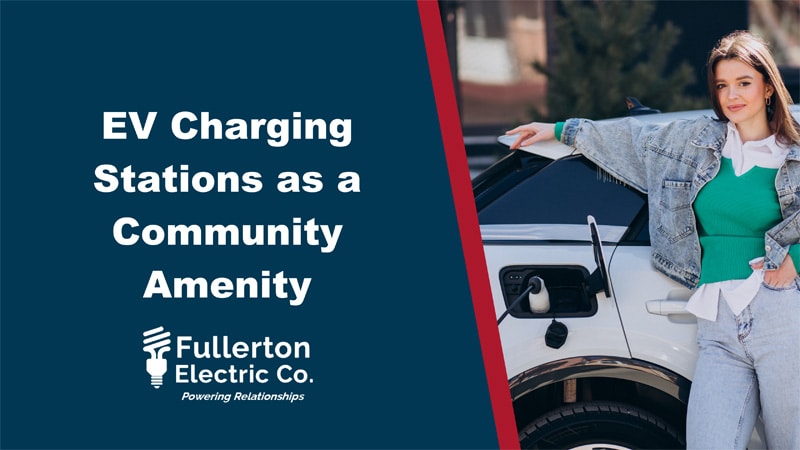Share
EV Charging Stations as a Community Amenity
Unless you’ve been driving down the freeways with your eyes closed, you’ve probably noticed the number of Teslas and other brands of electric vehicles (EVs) on our roads today. As the popularity of EVs increases, so does the demand for accessible charging infrastructure. For many EV drivers, most of their charging is expected to be done at home. Charging is relatively straight forward for drivers in single family homes, drivers in multi-unit dwellings however face difficulty. This article explores recent announcements by the automotive industry, the difficulties many EV drivers face, and how associations can benefit from accommodating EV drivers through the installation of charging stations.
Changes in the Car Industry:
The automotive industry is undergoing a transformative shift, with EVs emerging as a viable alternative to traditional gasoline-powered vehicles. Ford, GM, and many others have announced their plans to adopt Tesla’s North American Charging Standard (NACS) port on their new EVs by 2025, and work is being done to make the charging port the public standard in the United States. This will effectively unify the otherwise chaotic charging experience across many major car brands. This standardization is expected to boost EV adoption rates, particularly in California where adoption is already leading the nation.
Obstacles EV Drivers Face:
EV drivers in multi-family housing associations have to overcome many obstacles to charge their EVs in public or at home. Public high-speed chargers, found in parking lots and near freeways, are often crowded, leaving drivers to either wait in line for a charge or try and install a charger at home. Drivers that park in detached garages or a deeded spot have the right to install their own charging station for personal use according to Civil Code 4745. However, the infrastructure cost for a resident to install a charger is usually prohibitively expensive. Even if the work is done for that single driver however, the association’s infrastructure can usually only handle a few more installations before major upgrades by the association would need to be made. This is because the majority, if not all, housing associations constructed before 2018 were not designed to accommodate EV charging. These obstacles highlight the pressing need for better solutions to facilitate EV charging accessibility in communities.
How Properties Can Adapt:
If done properly, multi-family housing associations are in a unique position to cater to the needs of their residents who plan on owning EVs and reap the benefits that come with providing charging as a community amenity. Adding EV charging stations to residential complexes has several benefits that extend beyond the convenience of charging access.
Meeting the Growing Demand for EV Charging:
As the popularity of EVs continues to rise, so does the demand for charging stations. By installing a community owned charging station, residents without access to personal charging facilities can conveniently charge their vehicles. This proactive step not only addresses the growing need but also organizes what would otherwise be a messy charging situation with the potential for unequal access for residents. Installing charging stations as a community amenity ensures fair and equal access to charging resources, eliminating the potential for conflicts or inconveniences among residents. With stations available within the community, residents can efficiently manage their charging needs without having to consult with the board to install their own systems. This organized and inclusive approach enhances resident satisfaction and promotes a harmonious living environment within the community.
Resident Attraction and Potential to Increase Property Value:
The addition of EV charging as an amenity provides associations with a significant competitive advantage in attracting and retaining residents. By catering to the needs of EV drivers, associations can anticipate higher retention rates of long-term residents. Furthermore, the amenity of EV charging not only enhances resident attraction but also could contribute to an increase in property value, as it aligns with the preferences and expectations of the growing demographic of eco-conscious and tech-savvy residents. By embracing this trend and offering EV charging, associations can establish themselves as premier residential options, enjoying both enhanced resident satisfaction and long-term property value appreciation.
Future-Proofing Infrastructure:
Times are changing in California and there has been a large push towards electrification on all fronts, not just in the vehicle space, but for appliances, and heating as well. In the near future associations will likely have to consider their electrical infrastructure more than they ever had before. Providing EV charging infrastructure now instead of later allows communities to stay ahead of the curve and maintain control of their property’s electrical infrastructure. As the transition to electric vehicles gains momentum, associations must adapt to the changing needs of their residents. By proactively investing in community EV charging infrastructure, associations can limit the need for major electrical upgrades in the future.
Conclusion:
As the transition towards electric vehicles accelerates, the demand for convenient charging options will only continue to grow. By keeping up to date with changes in the consumer and regulatory world, associations can avoid the risk of being left with outdated and inadequate facilities. Future-proofing the infrastructure not only benefits current residents but also ensures the appeal and viability of the property for years to come. If your community wants is interested in taking the next step towards electrification see how Fullerton Electric Co. Is capable of helping! Contact us today at (888) 223-2727 or via email EVCharging@fullertonelectric.net!

